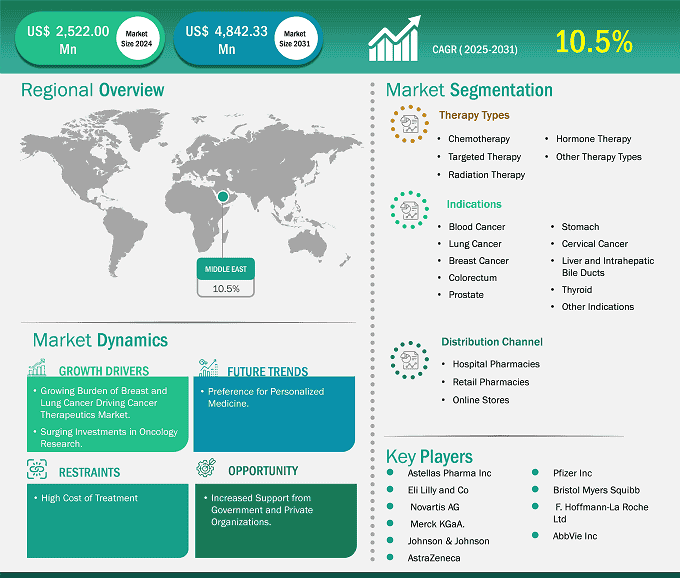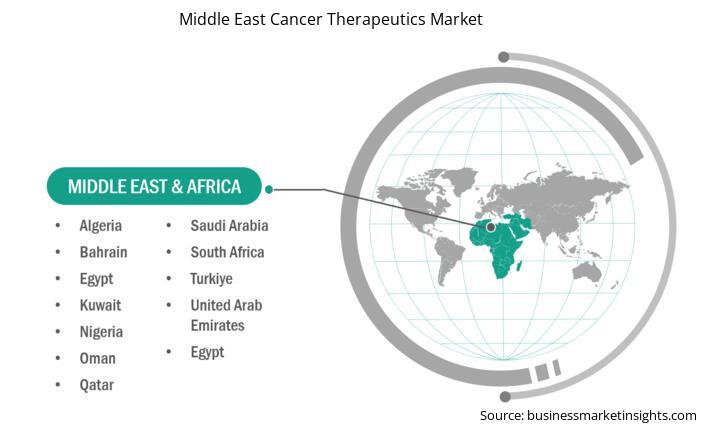Middle East Cancer Therapeutics Market Report (2021-2031) by Scope, Segmentation, Dynamics, and Competitive Analysis
No. of Pages: 150 | Report Code: BMIRE00031447 | Category: Life Sciences
No. of Pages: 150 | Report Code: BMIRE00031447 | Category: Life Sciences
The cancer therapeutics market size is expected to reach US$ 4,842.33 million by 2031 from US$ 2,307.69 million in 2024. The market is estimated to record a CAGR of 10.5 % from 2025 to 2031.
The cancer therapeutics market in Middle East is experiencing significant growth driven by several key factors, including significant advancements in healthcare infrastructure and an increase in the prevalence of cancer. The region is known for its economic wealth, and it has made strides in developing its healthcare sector to meet the rising demands of its aging population. Owing to the continuous evolution of healthcare systems, rising cancer incidence, burgeoning government support, and an increased focus on cancer care, the Middle East region is experiencing substantial growth in the cancer therapeutics market. The demand for innovative cancer treatment modalities such as immunotherapies and personalized medicine is rising in Middle East countries, and investments in healthcare systems and awareness programs are aiding in improved access to these therapies.

Key segments that contributed to the derivation of the cancer therapeutics market analysis are therapy type, indication, and distribution channel.
A significant rise in cancer cases in the region drives the need for cancer therapeutics in Middle East region. According to the GLOBOCAN 2022 Data, in 2022, ~4,347 new cancer cases were detected in Kuwait, among which breast cancer was the most prominent type, followed by colorectum cancer. As per the same source, the country recorded ~892 new breast cancer cases, representing 20.5% of all registered cases. The five-year prevalence rate for breast cancer in all ages was 211.30 per 100,000 population. It was also the major cause of cancer deaths in women, as it caused ~255 deaths in 2022.
Governments of various countries of the Middle East are investing heavily in healthcare infrastructure and cancer control programs. For instance, Qatar's government prioritizes healthcare as part of its National Vision 2030, which includes strengthening the country's healthcare system and promoting medical research. The Qatar Cancer Society, alongside institutions such as Hamad Medical Corporation (HMC), plays a crucial role in raising awareness and providing care. HMC's National Center for Cancer Care and Research (NCCCR) is a key facility offering advanced treatments, including chemotherapy, radiotherapy, and clinical trials for cancer patients. The Qatar Cancer Plan 2023–2026 sets out clear strategic objectives and deliverables to be accomplished by the end of 2026. These include a focus on key areas such as the development of palliative homecare services and precision medicine in cancer care. The cancer therapeutics market is expected to continue expanding in Qatar with these government initiatives and the burgeoning cancer burden.
Based on region, the Gulf Cooperation Council (Middle East) cancer therapeutics market is further segmented into Saudi Arabia, UAE, Kuwait, Oman, Qatar, and Bahrain. Saudi Arabia held the largest share in 2024.
The growth of the cancer therapeutics market in Saudi Arabia is driven by rising cancer incidence, growing healthcare infrastructure, and an increasing aging population. Saudi Arabia has been experiencing an upsurge in the incidence of cancer; the number of cancer-related deaths has also increased in the country. As per GLOBOCAN 2020 data, the country recorded ~27,885 new cancer cases, and the number is expected to rise to 60,429 by 2040. Also, the number of people aged 80 or more is expected to reach 1.6 million, i.e., 4% of the total population by 2050. Lifestyle changes such as increased tobacco use and poor dietary habits further elevate cancer risk in the Saudi population.
| Report Attribute | Details |
|---|---|
| Market size in 2024 | US$ 2,307.69 Million |
| Market Size by 2031 | US$ 4,842.33 Million |
| Global CAGR (2025 - 2031) | 10.5 % |
| Historical Data | 2021-2023 |
| Forecast period | 2025-2031 |
| Segments Covered |
By Therapy Type
|
| Regions and Countries Covered | Middle East and Africa
|
| Market leaders and key company profiles |
Astellas Pharma Inc; Eli Lilly and Co; Novartis AG; Merck KGaA.; Johnson & Johnson; AstraZeneca; Julphar Pharmaceuticals; Bristol Myers Squibb; SPIMACO ADDWAEIH; and Gulf Investment Corporation are among the key players operating in the market. These players adopt strategies such as expansion, product innovation, and mergers and acquisitions to stay competitive in the market and offer innovative products to their consumers.
The following methodology has been followed for the collection and analysis of data presented in this report:
The research process begins with comprehensive secondary research, utilizing both internal and external sources to gather qualitative and quantitative data for each market. Commonly referenced secondary research sources include, but are not limited to:
Note:
All financial data included in the Company Profiles section has been standardized to US$. For companies reporting in other currencies, figures have been converted to US$ using the relevant exchange rates for the corresponding year.
The Insight Partners conducts a significant number of primary interviews each year with industry stakeholders and experts to validate and analyze the data and gain valuable insights. These research interviews are designed to:
Primary research is conducted via email interactions and telephone interviews with industry experts across various markets, categories, segments, and sub-segments in different regions. Participants typically include:

The Middle East Cancer Therapeutics Market is valued at US$ 2,307.69 Million in 2024, it is projected to reach US$ 4,842.33 Million by 2031.
As per our report Middle East Cancer Therapeutics Market, the market size is valued at US$ 2,307.69 Million in 2024, projecting it to reach US$ 4,842.33 Million by 2031. This translates to a CAGR of approximately 10.5 % during the forecast period.
The Middle East Cancer Therapeutics Market report typically cover these key segments-
The historic period, base year, and forecast period can vary slightly depending on the specific market research report. However, for the Middle East Cancer Therapeutics Market report:
The Middle East Cancer Therapeutics Market is populated by several key players, each contributing to its growth and innovation. Some of the major players include:
The Middle East Cancer Therapeutics Market report is valuable for diverse stakeholders, including:
Essentially, anyone involved in or considering involvement in the Middle East Cancer Therapeutics Market value chain can benefit from the information contained in a comprehensive market report.